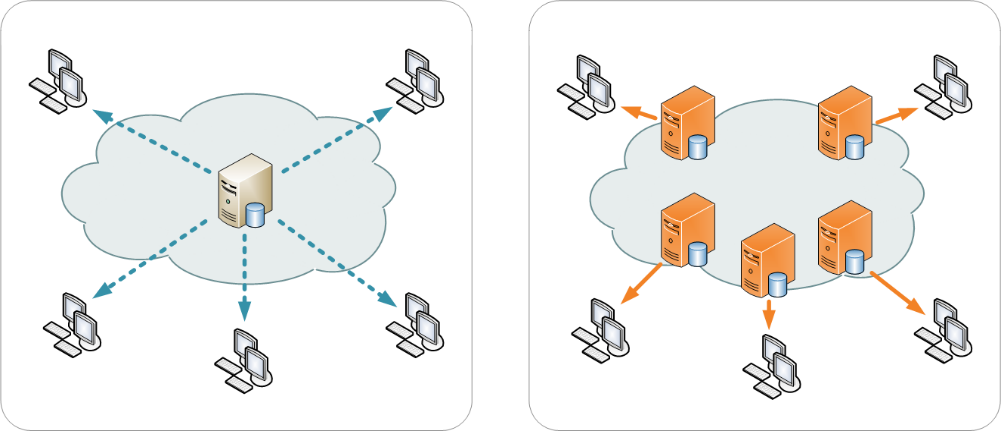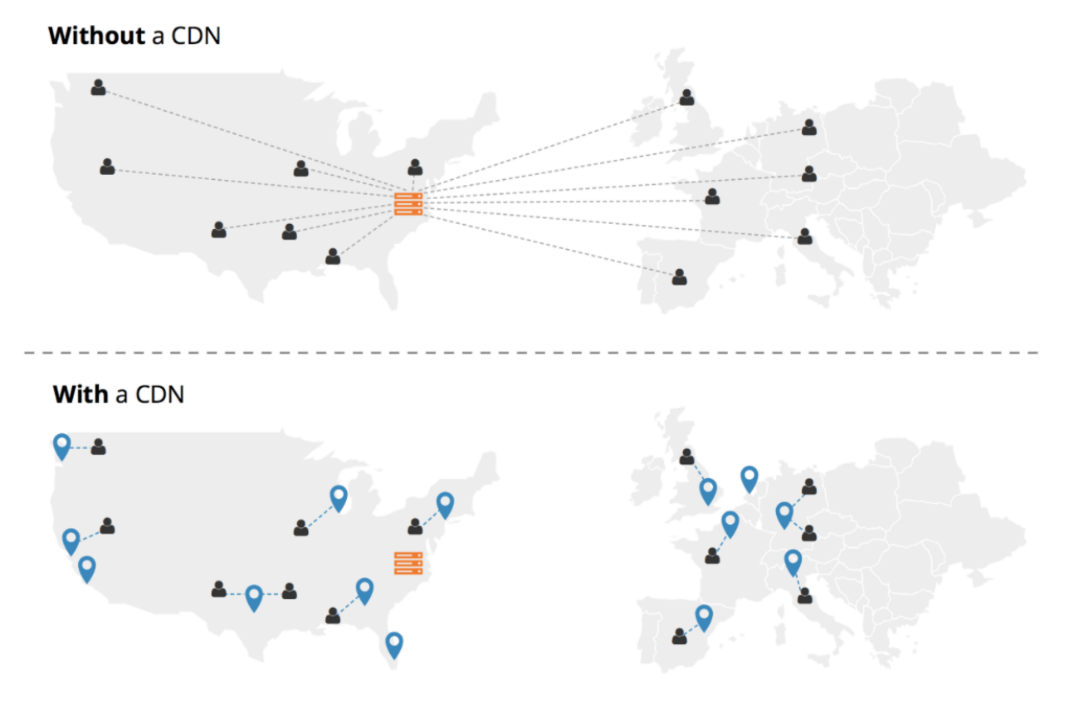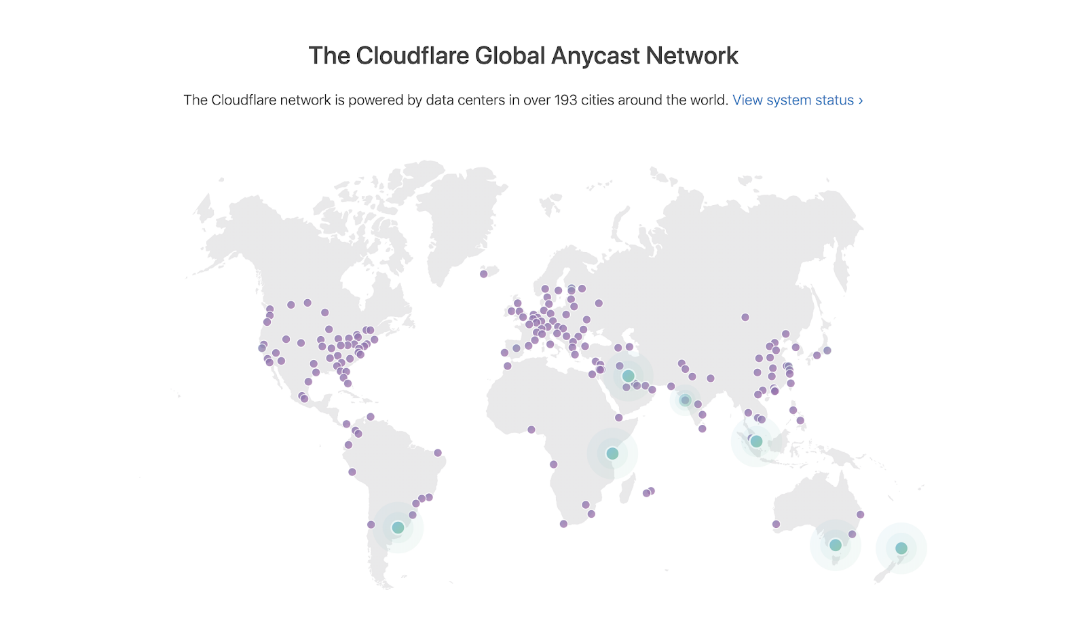The quick and simple answer to this question is that Cloudflare® is one of the world’s largest networks, and it seeks to better the internet through increased speed and security. However, this answer barely scratches the surface of the reality of what Cloudflare actually is.
To understand what it is, we need to start with a little history lesson.
History of Servers
At the beginning of the internet, when you wanted to visit a website, your request would be sent from your computer directly to a server. The server would then process your request and send you back the web page.

However, if the server received too many requests at once, the server would become overwhelmed, crash, and become unresponsive to anyone trying to access any of the resources on that server.
This crashing of servers made it difficult for servers to offer fast, reliable, and, most importantly, secure connections. Thus, enters Cloudflare.
What is Cloudflare?
Cloudflare is a network of servers spread all over the world, and this network acts as a sort of mediator between you and the server that holds the website you want to visit. By stepping in between the servers, Cloudflare protects against malicious DDoS attacks, slow loading speeds, and downtime between requests through the use of CDNs (Content Delivery Networks).

A CDN solves the problem of latency (delay before a transfer of data, i.e. long wait times). In today’s internet age, a page that takes longer than a few seconds to load tends to be exited and forgotten. So, if you purchase Cloudflare for your website, the CDN that Cloudflare offers eliminates this worry.

CDNs cache copies of websites registered within their servers into servers all over the world. This caching shortens the distance that a request has to travel to be accessed and thus reduces loading times. For example, if someone in Boston wants to access your Los Angeles-hosted webpage, they will access it through a Boston server rather than Los Angeles—a much faster process.
How Does Cloudflare Work?
Cloudflare works by caching your website and its files into its servers throughout the world, then when someone tries to access your site, their request is directed to the server nearest them. Doing this ensures that your webpage will load quickly regardless of traffic.
Cloudflare operates differently than a standard CDN in that it takes the fuss and hassle out of setting up and configuring a CDN. All you have to do to update your DNS (Domain Name System) to direct to Cloudflare. Cloudflare then asks you to choose two Cloudflare nameservers for your domain. You do this through the registrar you purchased your original domain through.
Side note:
Changing your hosting platform to Cloudflare does nothing to the nature of your website. Your domain remains the same as does your registrar. The only thing that making Cloudflare your hosting platform does is allow them to clean and accelerate your traffic.
The way that their acceleration works is through Cloudflare’s use of Anycast (a network routing technology), which routes the initial search for your domain to the data center and server closest to the visitor. The data center that receives the request sends back an answer, which then directs the visitor to the best server for them. Since Cloudflare has centers in almost 200 cities, you can be sure that speed will never be an issue.
Once the initial search request is processed, the server in proximity to the visitor begins serving up the actual website. This pulling of information is where Cloudflare works as a CDN, but with a few added features. When you use Cloudflare as your hosting platform, a large portion of your website’s data is cached inside every server to be quickly accessed by the visitor. As a bonus, one of Cloudflare’s added features is that the data center also screens every incoming IP address that tries to access your site. This screening acts as a defense against DDoS attacks and other threats to your site.

Once Cloudflare ensures that the visitor is not a threat, it then accesses its cache of your site and begins to serve it to your visitor. Cloudflare only stores the parts of your site that are static, things like images, Javascript, and CSS. Cloudflare tries to be conservative with what they cache for fear of messing up dynamic features like HTML. Only about 50% of any website ends up stored in the cache, but Cloudflare refreshes its cache frequently to assure that the cache is always up to date. The good news about this is that if much of your site is static and stored within their servers, then Cloudflare delivers the site extremely fast.
In the case that the visitor’s request isn’t cached, the server begins to pull the website to the local server from its original server. Because of the multitude of servers, the visitor is still given a premium “route” to your site, which tends to be much faster than trying to access the original server directly.
This combination of systems within Cloudflare means:
1. Your website is safe from malicious visitors.
2. You save over 60% of the bandwidth you would typically have to purchase, and over 65% of requests usually handled by your direct server.
3. The average load time of your site is halved.
Conclusion
Cloudflare is consistently placed in Forbes Cloud 100, and with good reason. Between their unparalleled content delivery speeds and exceptional DDoS protection, it’s easy to see why over 60,000 websites trust Cloudflare.
It makes CDNs secure and straightforward, but, more importantly, Cloudflare ensures that your visitors’ experience is quick and uninterrupted.

Your cornerstone to an effective domain name and brand management strategy.









